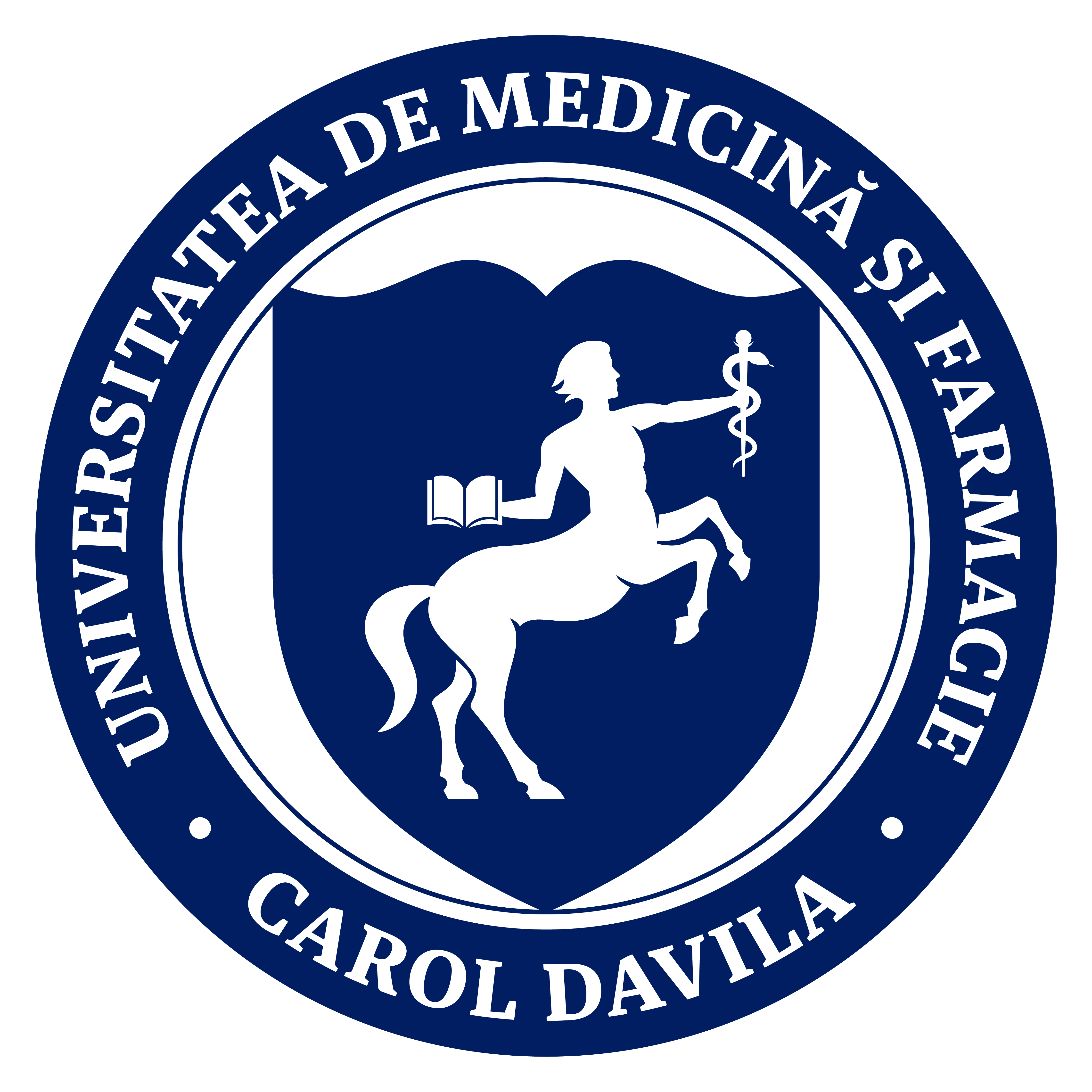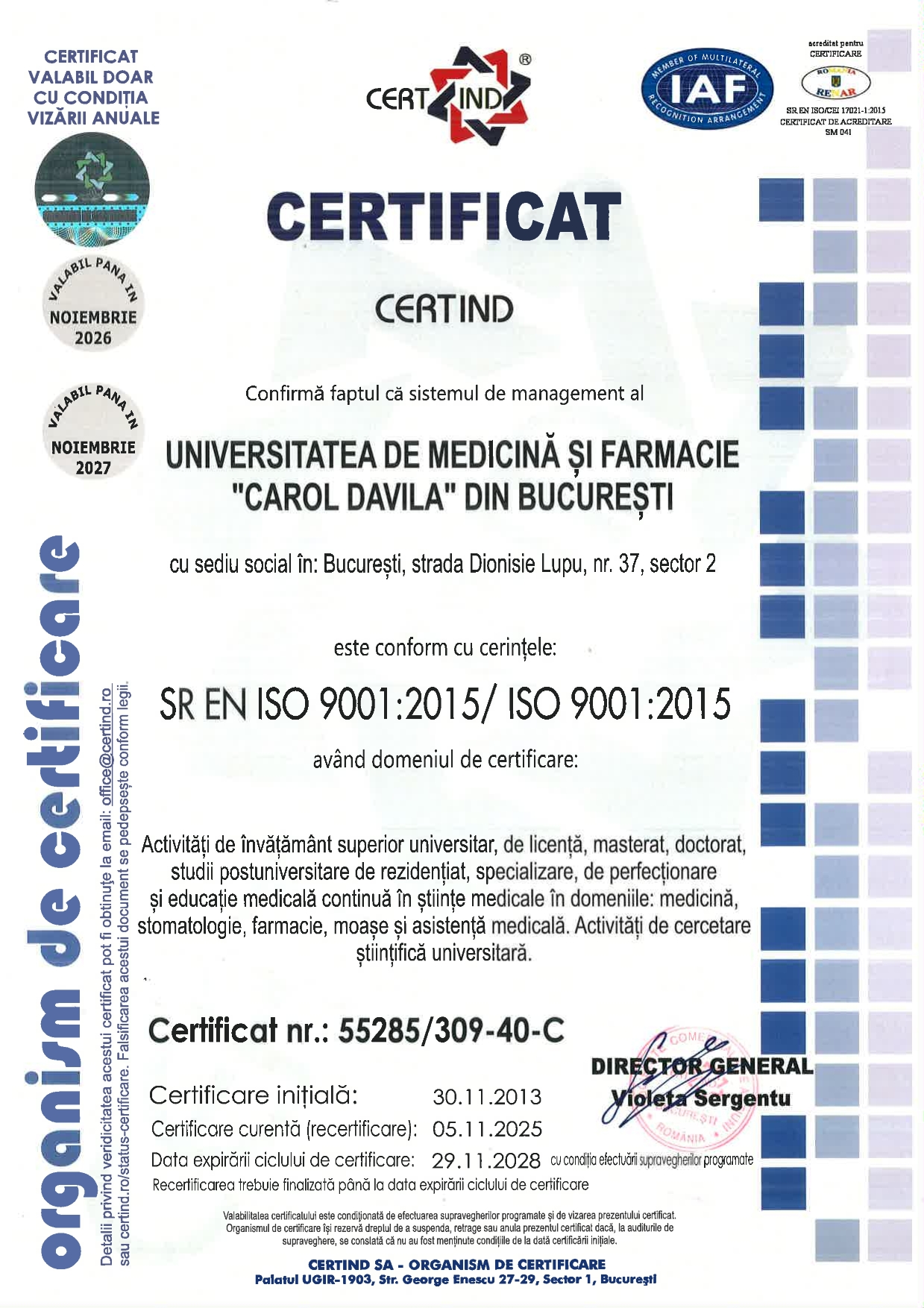Discipline - Pharmacology and Pharmacotherapy
- List of academic staff
- Brief history of the medical and research discipline
- Describing the research and didactic activities
- Useful information for the students
- Useful information for postgraduate students
- Useful information for postgraduate students
- 5-10 key words describing the subdomains of interest for the research activity
- 5 most representative research projects
- 8 most significant scientific papers
| Professor | Fulga Ion Gigel, PhD | tenured |
| Professor | Coman Oana Andreia, PhD | tenured |
| Associate Professor | Ghita Cristina Isabel Viorica, PhD | tenured |
| Associate Professor | Zugravu Aurelian, PhD | tenured |
| Associate Professor | Stoleru Smaranda-Florina, PhD | tenured |
| Associate Professor | Paunescu Horia, PhD | tenured |
| Head of works | Stanciu Liliana, PhD | tenured |
| Head of works | Costescu Mihnea, PhD | tenured |
| Assistant Professor | Lunca Dragos Constantin, PhD | tenured |
| Assistant Professor | Marin Ruxandra Cristina, PhD | tenured |
| Assistant Professor | Sorescu Adelina Mihaela, PhD | tenured |
| Assistant Professor | Nitescu Diana Ana-Maria, PhD | tenured |
| Assistant Professor | Barbu Aurelia Cristiana, PhD | fixed term |
Pharmacology was rooted in physiology, from which it took the experimental methodology and took over and developed into therapeutics and became the basis of rational use of drugs.
In our country pharmacology was developed predominantly in academic medical centers, professors of pharmacology and their teams are a key factor in promoting knowledge about medicine and research in this area. In the coming years it is likely to increase considerably the role of pharmacologists, pharmaceutical industry and the importance of pharmacological research.
The emergence of a Department of Pharmacology in the Faculty of Medicine in Bucharest, the oldest department of its kind in the country, required several stages of relative distinction.
A first step arose from the need to build a pharmacology education for physicians and pharmacists and this stage is mainly linked to the names of three personalities, pharmacists Pruzinsky Francis and Frederic Gaudy, and Constantin Hepites who was equally a doctor and a pharmacist. In fact Hepites was a scholar. He studied mineralogy, chemistry, botany, pharmacy and medicine. This stage lasts for approximately 1856 first documentary attestation of a university pharmacology and 1864 when Hepites leaves education. Subsequently pharmacology education development is promoted mainly by doctors.
A second phase is primarily related to the professors Nicolae Maldarescu and Zaharia Petrescu. It is a stage where pharmacology education is taught sometimes in separate disciplines, by both physicians and pharmacists, either only in the Faculty of Pharmacy, or only in the Faculty of Medicine, or distinct from the two faculties, namely the Faculty of Sciences. This stage lasts until 1901 when the Department of Pharmacology takes the title "Clinical Pharmacology and Therapeutics Department".
After 1901 the chair becomes practically an institution that has a well defined upward continuous trend, under the leadership succesors of professors Nicolae Petrescu and Zaharia Maldarescu respectively in order, Professor Dimitrie Ionescu (1912-1920), Professor Socrates Lalu (from 1920 to 1940 ), Professor Peter Niculescu (1942-1944), Professor Ion NiALescu (at the Department of Physiology who teaches pharmacology as locum-tenens (acting professor) between 1940 and 1947), Professor Alfred Teitel (1947-1074), Professor Valentin Stroescu (1974-2000) and currently (since 2000), Professor Ion Fulga.
General objective:
- To develop, in the context of pharmacology, the knowledge, skills, attitudes and behaviors necessary for the optimal conditions of a medical career.
Course objectives:
- Understanding and knowledge of drug action on the organism as a whole, how they affect the human body functions and applying this knowledge into medical practice.
- Acquiring the necessary bases as appropriate use of medicines in the prevention, diagnosis and treatment of diseases and illnesses.
- Evaluate the benefits and risks of medication use alone or in various regimens.
- Acquiring knowledge necessary for the individualization of treatment depending on the particular patient.
- Understanding the mechanisms of molecular and cellular action of the main groups of drugs.
- Knowledge of fundamental concepts concerning the pharmacokinetics and the possibility of their use to determine the dosage, intervals of administration and individualization of treatment in different patient populations.
- Monitoring of drug treatment in terms of efficacy, side effects and drug interactions.
- Understand pharmacodynamic and pharmacokinetic peculiarities of drugs in different patient groups (elderly, children, pregnant or breastfeeding women, patients with renal or hepatic impairment).
- Knowing the basics of addiction and dependency on drugs and ways of prevention and treatment of acute and chronic poisoning with drugs.
Practical Course objectives:
- Knowing how drugs are discovered and evaluated in experimental terms.
- Critical analysis of scientific literature on drugs.
- Rational use of electronic scientific databases in the field of medicine.
- Rational analyzing of the predictability of experimental data for clinical efficacy and safety of medicines.
- The ability of writing a complete, accurate and rigorous, prescription, including medicines involving a special prescribing.
- Rational prescribing of drugs acting on different systems of the body.
Discipline’s research objectives:
- Neuropsychopharmacology;
- Vascular Imaging;
- Assessment of effects on brain electrical activity (EEG) of some substances;
- Pain and inflammation;
- Studies on isolated organs;
- Studies on the scarring process
- Neuropsychopharmacology;
- Anxiety;
- Learning and memorisation;
- Depression;
- Sedation;
- Analgesics;
- Inflammation;
- Blood vessel contractility;
- Scarification;
- Blood vessel formation
- Study of the endogenous cannabinoid’s drug interfering system.
- The study of brain nicotinic system and it’s influence through drugs.
- Research on new types of pharmacological analgesia.
- Study of ocular, conjunctival and iris’s vascularization.
- Studies on the cholinergic and serotonin intestinal systems.
RO
- Farmacopeea Romana Editia a-X-a, Supliment 2000, Ion Fulga (coordonator), Ed. Medicală, Bucureşti, 2000.
- Farmacopeea Romana Editia a-X-a, Supliment 2001, Ion Fulga (coordonator), Ed. Medicală, Bucureşti, 2001.
- Progrese în domeniul medicamentului, Ion Fulga, Ed. Medicală, Bucureşti, 2003.
- Farmacologie. Ion Fulga (coordonator). Ed. Medicală, Bucureşti, 2004, 2006.
- Farmacologie, ediția a II-a revizuită și adăugită. Ion Fulga (coordonator). Ed. Medicală, Bucureşti, 2015.
- The analgesic effect of gemcitabine in mice. C. Fulga, A. Zugravu, I. Fulga, Rom. J. Intern. Med., 2006, 44(3), p. 335-350. – Prima semnalare a unui efect analgezic al unui citostatic.
- The use of diethylamine as analgesic in pharmaceutical preparations. Brevet de invenție Nr. 122835, Fulga Ion, Fulga Carmen, 2006.
- Efectele serotoninei asupra reactivității vasculare oculare. Oana Andreia Coman, Oana Raluca Savu, Isabel Ghiță, H. Păunescu, L. Coman, I. Fulga. Oftalmologia nr. 4, 2007. – Prima semnalare a unei diferențe de receptori farmacologici între vascularizația iridiană și cea conjunctivală.
EN
- Romanian Pharmacopoeia Romana 10th Edition, Supplement 2000, Ion Fulga (coordinator), Medical Publishing House, Bucharest, 2000.
- Romanian Pharmacopoeia Romana 10th Edition, Supplement 2001, Ion Fulga (coordinator), Medical Publishing House, Bucharest, 2001.
- Developments in the field of drugs, Ion FUlga, Medical Publishing House, Bucharest, 2003.
- Pharmacology. Ion Fulga (coordinator). Medical Publishing House, Bucharest, 2004, 2006.
- Pharmacology, 2nd editin, revisited and updated. Ion Fulga (coordinator). Medical Publishing House, Bucharest, 2015.
- The analgesic effect of gemcitabine in mice. C. Fulga, A. Zugravu, I. Fulga, Rom. J. Intern. Med., 2006, 44(3), p. 335-350. – The first signaling of an analgesic effect of a cytostatic drug
- The use of diethylamine as analgesic in pharmaceutical preparations. Invention brevet No. 122835, Fulga Ion, Fulga Carmen, 2006.
- The effects of serotonin on ocular vascular activity. Oana Andreia Coman, Oana Raluca Savu, Isabel Ghita, H. Paunescu, L. Coman, I. Fulga. Ophtalmology no. 4, 2007. – The first signaling of a difference of pharmacological receptors between the iris’s and conjunctiva’s vascularization.



